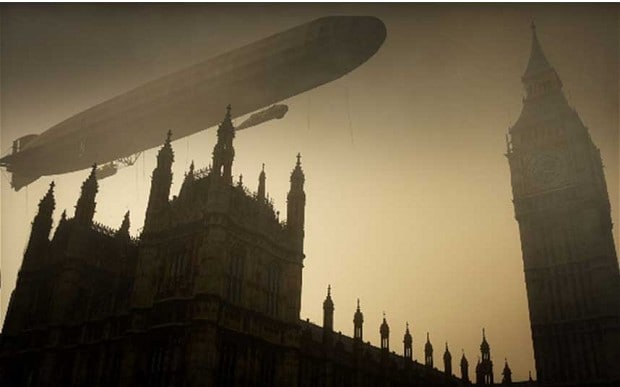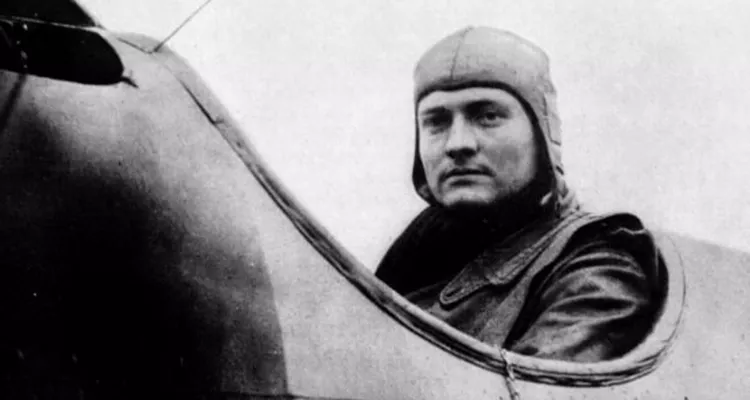German Airship Explodes Over London.
Thousands Flock to See It Burn.
German Ace Arrives.
Special to The Great War Project.
(1-4 September) The war in the skies comes to London. On September 2nd, precisely a century ago, German airships mount their deadliest air raid so far in the war.
“Sixteen German naval and army airships set off in a joint-attack over eastern England,” writes historian Martin Gilbert. “It was the largest raid ever mounted.”

Depiction of Zepellin attack on London
Ten of the German airships cross the North Sea and reach London around midnight. They drop their bombs and then flee. A British aircraft chases one of the airships, which according to Gilbert, attempts to escape by weaving its way “through a fierce anti-aircraft artillery barrage.”
Then it explodes, becoming the first airship brought down by a new incendiary bullet.
“It fell to the ground in flames,” reports Gilbert, its destruction seen by thousands of people who gathered on roofs and in the streets to watch it.”
The glow of the burning airship can be seen some thirty-five miles away. “This was the moment,” one historian writes, “that so many Londoners had waited to see for so long, and they made the most of it.”

Wreckage of German airship after bombing raid over England.
“Complete pandemonium broke out as people rushed out on the streets. Singing, clapping, and cheering seemed to go on and on echoing over the rooftops.”
Parents held their children up to their windows to see the burning glow. “For many it would be a lasting impression even over sixty years later.”
One eyewitness is ten-year-old Henry Tuttle. “We opened the front door and there it was,” he recalled years later. “It was a fantastic sight. A lot of people came out or their houses and then all of a sudden it broke in half and was one mass of flames.”
“It was an incredible sight,” Tuttle recalls, “and went on well into the night.”
According to Gilbert, “in the forty-eight hours after the airship had been brought down, 10,000 people went by train to visit the scene and search for souvenirs.”
But people are shocked by the danger from the airships. In this one raid, they drop 371 bombs – not a small number.

British response to German air raid over London
The airship attack demonstrates to Londoners just how vulnerable they are from the war in the skies. In subsequent airship attacks on London, the German Zeppelins drop hundreds more bombs on the British capital.
At this moment in the war, a new element is added to the war in the skies. The German pilot Baron Manfred von Richthofen shoots down his first British plane over the Western Front. His first opponent there is Second Lieutenant Lionel Morris.

German ace pilot Manfred von Richthofen.
“My Englishman twisted and turned, flying in zig-zags,” Richthofen writes immediately after he encounter. “I was animated by a single thought; the man in front of me must come down, whatever happens…then instead of twisting and turning he flew straight along. In a fraction of a second I was at his back…I gave a short burst of shots with my machine-gun. I had gone so close that I was afraid I might crash into the Englishman.”
“Suddenly,” Richthofen recalls, “I nearly yelled with joy for the propeller of the enemy machine had stopped turning. Hurrah! I had shot his engine to pieces.”
Richthofen watches as the British plane attempts to land safely. He too lands his plane and runs to see what had happened to his adversary.
“When I arrived,” Richthofen recounts, “I discovered I had shot the engine to pieces and both the pilot and the observer [in the second seat] were severely wounded.”
“The observer died at once, and the pilot while being transported to the nearest dressing station. I honored the fallen enemy by placing a stone on his beautiful grave.”
It is only the beginning of warfare in the skies.

Minor point: Richthofen’s first confirmed kill was on 17 September 1916. The date stands out for me as that is the same day (not year) as my father’s birthday.